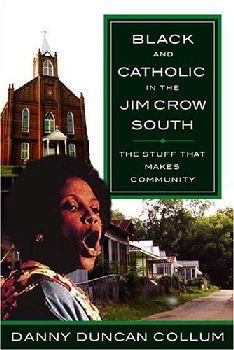
|
Posted April 23, 2006
Book: Black and Catholic in the Jim Crow South: The Stuff that makes Community Author: Danny Duncan Collum Paulist Press, NY, 2006, pp. 178 An Excerpt from the Jacket:
One such agent of change was Holy Family Church in Natchez. Founded in 1890 as the first African American Catholic parish in Mississippi, it had become by the 1960s a center for struggle and hope, standing at the heart of the African American freedom movement. Based on oral histories of Holy Family, Black and Catholic in the Jim Crow South tells the story of the twentieth-century struggle of black Catholics, through the voices of the people who lived it. It tells of the origins of the parish, the early illicit relations between white Catholics and black slaves or servants, and the central role that Holy Family Church played in the civil rights movement. An Excerpt from the Book: Wilbur Johnson I have tremendous hope for Holy Family. I’m on the school board, so I’m going to talk about the school first, then I’m going to talk about the church. We are trying to move Holy Family to one of the top elementary schools in this area from K through six. We’re going to try to get the best qualified personnel and offer better opportunities. We got a new concert band, for instance. And we just hope that we’re going to be able to grow. Our biggest problem is money. However, we’re just going to try to find some way, the Lord bless us, through the projects and proposals and grant-writing to get something. We feel as though the Lord will help us in some kind of way. As far as the church is concerned, we have several drives. Physically, we need an elevator; we need some repairs. Holy Family’s at a point where we got to do a lot of work on it, but I see a great future for Holy Family. As far as church is concerned, we’re experiencing something now that a lot of people are not ready for or don’t understand. We are being permitted to participate in Mass according to our culture — black culture — instead of the idea that someone has given us of another man’s culture. Some of our parishioners are not ready for it. They feel as though it is sacrilegious to stomp your feet and say “Amen” or “Thank you, Lord.” They like the old traditional way of kneeling down and being quiet. Even though your heart is bursting to say “Amen,” hold it in. So we got a struggle there, but, eventually they’ll look and see others and become more aware and let themselves go and say “Amen,” too. This style of Mass is new for me, too, but I like it. I’m like some of the old ones; it takes me a little bit. I’m not the one that says “Amen,” but I find myself beginning to mumble a little bit, and beginning to clap my hands, and I don’t mind raising my hands, and I don’t mind saying “Thank you, Lord,” and it feels good. Table of Contents: 1. Prelude 2. “Historic Natchez” 3. Early days 4. School days 5. Color lines 6. Faith and family 7. A place to turn 8. New day coming 9. Walking the walk 10. Paying the price 11. Father Morrissey 12. Integration 13. Black and Catholic Today 14. A Southern road to freedom |
|
